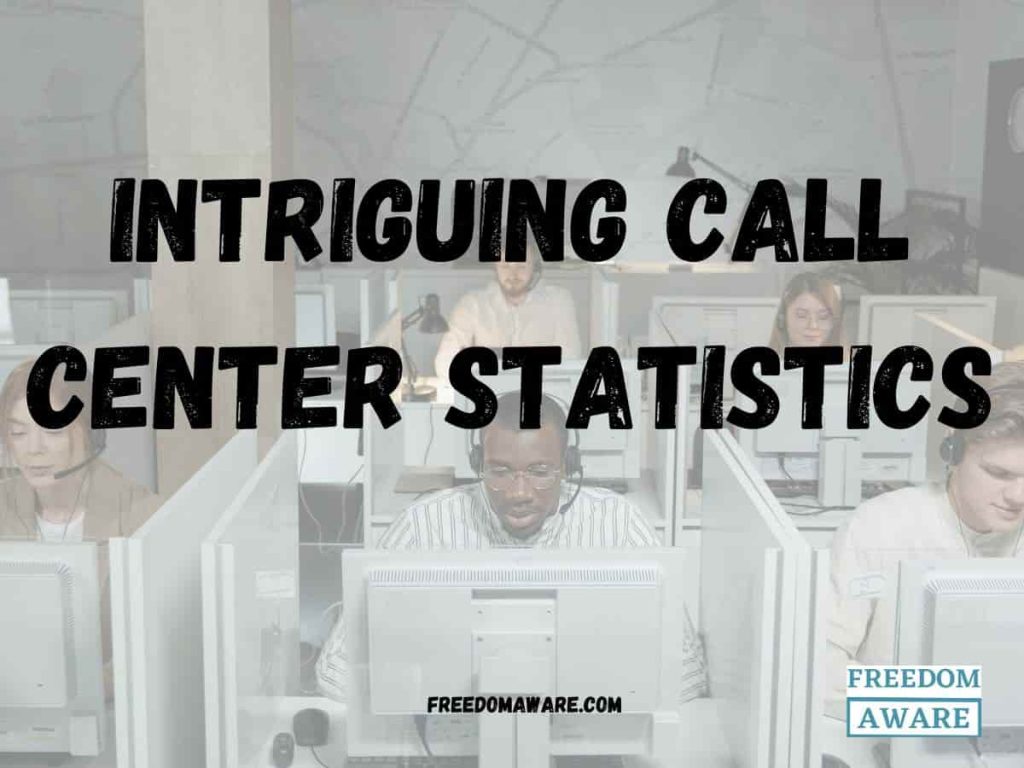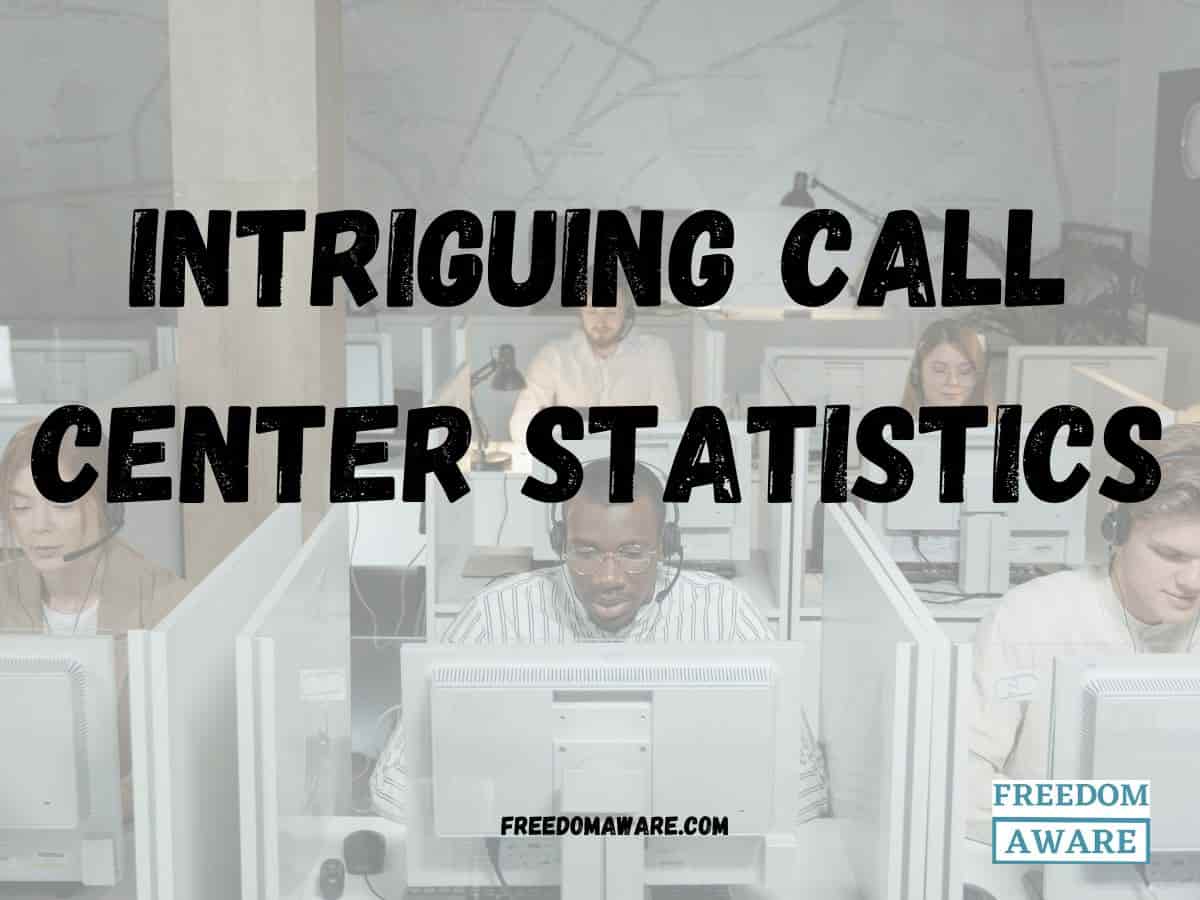
Call Center Statistics: The Industry (A Snapshot)
Call centers remain a vital customer interaction channel. With millions of calls handled daily, the industry is constantly evolving. This article delves into key statistics, emerging trends, and challenges shaping the call center landscape.
Discover the latest insights and trends driving the call center industry.
Call Center Industry by the Numbers (Call Center Statistics)
The call center industry is experiencing significant growth. Here’s a snapshot of key statistics:
- Market Growth: The global call center market is projected to reach $494.7 billion by 2030, growing at a CAGR of 5.8%.
- Industry Size: The US boasts approximately 2.9 million call center employees.
- Customer Preference: 86% of consumers value call center services.
- AI Integration: The call center AI market is estimated to reach $2.8 billion by 2024.
- Call Volume: The average call center handles about 4,400 calls monthly, with a 48-call miss rate.
These figures highlight the industry’s scale and the increasing demand for efficient and effective customer service.
Want to explore specific trends or challenges within the call center industry?
Call Center Industry: Key Statistics
The call center industry is a significant player in global customer service. Here’s a breakdown of key figures:
- US Dominance: The US maintains a strong position in the call center industry regarding employment and expansion. (source)

- Global Market Growth: The global call center market is booming and is expected to reach $494.7 billion by 2030 from $314.5 billion in 2022. (source)
- US Workforce: Over 2.9 million people were employed in the US call center industry in 2022. (source)
- Industry Leaders: Tata Consultancy Services and Genpact are leading players, generating billions in revenue. (source)
- Job Growth Challenges: The US experienced a significant decline in call center job creation from 2016 to 2022. (source)
- Global Market Growth: Valued at $314.5 billion in 2022, it’s projected to reach $494.7 billion by 2030, growing at a CAGR of 5.8%. (source)
- US Workforce: Employed over 2.9 million people in 2022. (source)
- Top Players: Companies like Tata Consultancy Services ($27 billion revenue) and Genpact ($4 billion revenue) are industry leaders. (source)
- Job Market Fluctuations: The US experienced a significant decline in call center job creation from 2016 to 2022. (source)
- Consumer Reliance: 86% value call center services, highlighting the need for human interaction. (source)
- Call Transfers: The average caller is transferred 2.6 times before resolving their issue. (source)
- Customer Preference: Most consumers prefer human interaction over automated systems. (source)
- Increased Call Volumes: Call center leaders report increased call volumes since the pandemic. (source)
- Average Handling Time (AHT): The typical call center benchmark for AHT is six minutes. (source)
- Call Duration and Hold Times: Average call duration is 302 seconds, with an average hold time of 25.8 seconds. (source)
- Generational Preferences: Millennials and Gen Z demonstrate varying confidence levels and reliance on call centers. (source)
- Generational Differences: While Millennials have some confidence in call centers, Gen Z strongly prefers digital channels. (source)
- Agent Productivity: Agents spend approximately 32 minutes on customer interactions per hour, with the remaining time allocated to after-call work, breaks, and meetings. (source)
- Customer Expectations: Consumers increasingly demand personalized interactions and faster response times. (source)
- Call Center Performance Metrics: First-call resolution rates, average handle time, and answer speed are critical performance indicators. (source)
- Customer Preferences: Phone calls remain a preferred support channel, especially for complex issues. However, there’s a growing preference for faster response times and digital communication channels. (source)
These statistics show the industry’s size, growth trajectory, and employment landscape.
The Rise of AI in Call Centers (Call Center Statistics)
AI is transforming the call center industry. Here are key statistics:

- Market Growth: The call center AI market is expected to reach $2.8 billion by 2024, growing at a CAGR of 23.1%. (source)
- Automation Surge: AI automation in agent interactions will increase fivefold by 2026. (source)
- Agent Empowerment: Two-thirds of contact center managers believe AI will enhance agent capabilities. (source)
- Cost Savings: Conversational AI is projected to save $80 billion in labor costs by 2026. (source)
- AI Adoption: One in ten agent interactions will be automated by AI by 2026. (source)
These statistics highlight the significant impact of AI on the call center landscape.
The Impact of Customer Experience on Call Center Success (Call Center Statistics)
Customer experience is a critical driver of business success. Here’s how call centers play a role:
- Revenue and Market Share: Poor customer experience poses significant risks to revenue and market share. (source)
- Customer Loyalty: Exceptional customer experiences can lead to a 16% price premium and increased customer loyalty. (source)
- Customer Satisfaction: 95% of call center professionals prioritize customer satisfaction as a key performance indicator. (source)
- Customer Churn: Negative call center experiences can lead to customer attrition, with 59% of US customers considering switching brands after multiple bad experiences. (source)
The Impact of Customer Experience on Brand Loyalty (Call Center Statistics)
Customer experiences significantly impact brand loyalty and purchasing decisions. Here’s a breakdown:

- Global Impact: Negative call center experiences can lead to customer attrition, with 32% of Latin American and 59% of US customers considering switching brands. (source)
- Customer Expectations: Speed, convenience, knowledge, and friendliness are key components of a positive call center experience. (source)
- Purchase Influence: Excellent call center service can significantly influence purchasing decisions, with 83% of customers reporting a positive impact. (source)
- Customer Sentiment: Poor call center experiences lead to negative emotions, such as disappointment, unhappiness, and anger. (source)
- Word-of-mouth: Negative experiences are often shared with others, while positive experiences can drive brand loyalty and new customer acquisition. (source)
Key Call Center Performance Metrics (Call Center Statistics)
Measuring call center performance is crucial for identifying areas for improvement. Here are the key metrics:
- Customer Satisfaction (CSAT): This metric gauges customer happiness and satisfaction. A good CSAT score typically falls between 75% and 85%. (source)
- First Call Resolution (FCR): Measures the percentage of customer issues resolved on the first call. High-performing call centers aim for an FCR rate of 70% or higher. (source)
- Average Handle Time (AHT): This represents the average duration of a customer call, including hold times, transfers, and after-call work. The industry average is around 6 minutes. (source)
Key Call Center Performance Metrics (Call Center Statistics)
Measuring call center performance is crucial for identifying areas for improvement. Here are the key metrics:
- Customer Satisfaction (CSAT): This metric gauges customer happiness and satisfaction. A good CSAT score typically falls between 75% and 85%. (source)
- First Call Resolution (FCR): Measures the percentage of customer issues resolved on the first call. High-performing call centers aim for an FCR rate of 70% or higher. (source)
- Average Handle Time (AHT): This represents the average duration of a customer call, including hold times, transfers, and after-call work. The industry average is around 6 minutes. (source)
- Occupancy Rate: Ideally, the rate is between 80-85%. This metric measures the percentage of time agents are actively engaged with customers. (source)
- Average Speed of Answer (ASA): The target is under 28 seconds, representing customers waiting before their call is answered. (source)
- Customer Abandonment Rate: Should be between 2-5%. Higher rates indicate poor call center performance. (source)
- Service Level: Typically around 81.5%, this metric measures the percentage of calls answered within a specified time. (source)
Challenges Facing the Call Center Industry (Call Center Statistics)
The call center industry faces several challenges impacting operations and customer satisfaction:
- High Attrition Rates: The sector struggles with a 42% attrition rate due to factors like burnout and lack of support. (source)
- Service Strategy Gaps: Poor service strategies, such as limited personalization, negatively impact customer experience. (source)
- Wait Time Impact: Longer wait times correlate with lower customer satisfaction scores and potential revenue loss. (source)
- Personalization Challenges: Delivering personalized interactions is crucial but needs more customer understanding. (source)
- Technical Issues: Technical glitches can disrupt operations and negatively impact customer experience. (source)
- First Call Resolution (FCR): Measures the percentage of customer issues resolved on the first call. A higher FCR rate indicates efficient problem-solving and reduced customer effort. (source)
- Average Handle Time (AHT): This represents the average duration of a customer call, including after-call work. Optimizing AHT enhances agent efficiency. (source)
- Occupancy Rate: Measures the percentage of time agents are actively handling calls. Balancing occupancy is essential for agent well-being and operational efficiency. (source)
- Average Speed of Answer (ASA): Reflects the average wait time for customers. Minimizing ASA improves customer satisfaction. (source)
Key Call Center Performance Metrics (Call Center Statistics)
Effective call center management relies on key performance indicators (KPIs). Here’s a breakdown of crucial metrics:

- Service Level: Measures the percentage of calls answered within a specific timeframe. An 80% service level within 20 seconds is a common industry standard. (source)
- Abandonment Rate: Indicates the percentage of callers who hang up before their call is answered. A rate below 5% is considered good. (source)
- Abandonment Wait Time: Understanding when customers abandon calls (often at 30 and 60 seconds) helps optimize call handling. (source)
- Schedule Adherence: Measures how closely agents adhere to their schedules, with a recommended rate of 85% or higher. (source)
Industry-Specific Performance Metrics (Call Center Statistics)
- Financial Services: A 79% customer satisfaction score highlights the industry’s focus on customer satisfaction. (source)
- Healthcare: A 7% abandonment rate indicates efficient call handling in the healthcare sector. (source)
- E-commerce: A 75% first-call resolution rate demonstrates a focus on resolving customer issues quickly. (source)
- Technology: A 79% service level reflects the industry’s commitment to timely call answering. (source)
- Retail: A low customer satisfaction score of 39% indicates challenges in meeting customer needs. (source)
- Telecom: An 80-90% occupancy rate suggests efficient agent utilization in the telecom industry. (source)
- Automotive: A 78% customer satisfaction score highlights the industry’s focus on customer satisfaction. (source)
Emerging Trends in the Call Center Industry (Call Center Statistics)
The call center industry is undergoing significant transformation driven by technological advancements and evolving customer expectations. Key trends include:
- Voice Assistant Integration: With over 8.4 billion voice assistants projected for use by 2024, businesses can leverage this technology to offer efficient self-service options. (source)
- Cloud-Based Contact Centers: The shift towards cloud-based contact center solutions (CCaaS) is gaining momentum, offering scalability and enhanced customer experiences. (source)
- Omnichannel Engagement: Customers expect seamless interactions across multiple channels, driving the growth of omnichannel customer engagement solutions. (source)
- Remote Agent Workforce: The trend towards remote work is expanding the call center agent pool, offering flexibility and cost savings. (source)
- Sentiment Analysis: Advancements in sentiment analysis enable businesses to better understand customer emotions, tailoring interactions accordingly. (source)
Call Centers: Evolving to Meet Modern Customer Demands (Call Center Statistics)
The call center landscape is undergoing a rapid transformation, driven by technological advancements and evolving customer expectations. To thrive in this dynamic environment, businesses must adapt to several key trends.
Automation and AI: Your New Call Center Powerhouse (Call Center Statistics)
Leveraging automation and artificial intelligence (AI) is no longer optional but essential for call centers. AI-powered tools like virtual agents and chatbots are revolutionizing customer interactions by providing instant, accurate responses to common queries. This frees up human agents to focus on more complex issues, enhancing overall efficiency and customer satisfaction. Furthermore, AI-driven analytics offer valuable insights into customer behavior, enabling data-driven decision-making and personalized service.
Personalization: Building Stronger Customer Relationships (Call Center Statistics)
Gone are the days of generic customer service. Today’s consumers crave personalized experiences. By harnessing customer data, call centers can tailor interactions to individual preferences, creating a sense of connection and loyalty. From recommending products based on purchase history to routing customers to agents familiar with their accounts, personalization is key to standing out in a crowded marketplace.
Omnichannel Excellence: Meeting Customers Where They Are (Call Center Statistics)
Consumers expect seamless interactions across multiple channels. Call centers must adapt by offering support through phone, email, chat, social media, and more. A consistent customer experience, regardless of the channel, is crucial for building trust and satisfaction. By integrating these channels, businesses can provide efficient and convenient support, increasing customer engagement and loyalty.
Cloud Power: Flexibility and Scalability at Your Fingertips (Call Center Statistics)
Cloud technology is reshaping the call center industry by offering unparalleled flexibility and scalability. By adopting cloud-based solutions, businesses can eliminate the need for costly on-premises infrastructure and quickly adapt to changing demands. Additionally, cloud platforms often incorporate advanced features like speech recognition and natural language processing, empowering call centers to deliver cutting-edge customer experiences.
Data-Driven Success: Unlocking Insights for Growth (Call Center Statistics)
Advanced analytics is transforming call centers into data-driven operations. By analyzing customer interactions, businesses can identify trends, preferences, and pain points. These insights enable call centers to optimize processes, improve agent performance, and deliver proactive support. Data-driven decision-making is essential for staying ahead of the competition and delivering exceptional customer experiences.

In conclusion, call centers that embrace these trends will be well-positioned to succeed in the evolving customer landscape. By investing in automation, personalization, omnichannel capabilities, cloud technology, and data analytics, businesses can create efficient, customer-centric operations that drive growth and loyalty.


Leave a Reply